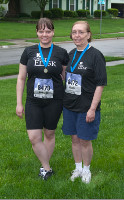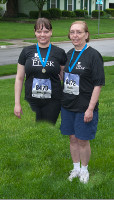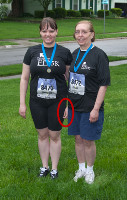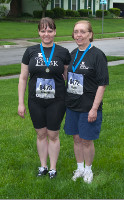Body Snatching with Photoshop
On May 1, my wife, Phyllis, and younger daughter, Kaydee, participated a local television station’s Commit to Be Fit 5K walk and run. I took their pictures after the event, several with Phyllis, Kaydee, and one of Kaydee’s friends and several with just Phyllis and Kaydee. What I didn’t notice was that in the pictures of Phyllis and Kaydee, Kaydee was standing with her legs in an odd position. As recently as a few years ago, there would have been no way to remedy this. Today it’s easy.
Some of the things we take for granted these days would have been all but impossible just a few years ago and this year we’ll be able to take even more magic for granted. Adobe has just released its Creative Suite 5, which includes new versions of Photoshop, Camera Raw, and Bridge. Before the end of the year, Adobe will also release version 3 of its amazing Lightroom application, which is now available as a public beta.
 I started with the image of Phyllis and Kaydee as the base.
I started with the image of Phyllis and Kaydee as the base.
There's really nothing wrong with the position of her legs, but I thought the image would work better without the crossed feet.
 Another image, with Kaydee in the middle of a group had her legs in what I considered to be a "normal" position.
Another image, with Kaydee in the middle of a group had her legs in what I considered to be a "normal" position.
This image was made a few seconds before the other. Kaydee hadn't moved and neither had I, so my goal was to select a rectangular section beginning about where the sign ended and superimpose it on the original image.
The positions were just enough different that I needed a clear area around where her legs were.
 So by using a layer mask, I replaced Kaydee’s legs with grass.
So by using a layer mask, I replaced Kaydee’s legs with grass.
The new grass is cloned from another area of the image and I placed it on a separate layer so that I wouldn't harm the original photo.
 The next step involved copying a section of the other image and placing it in another layer of the image I was working on, but notice the extra hand! This is a common Photoshop error.
The next step involved copying a section of the other image and placing it in another layer of the image I was working on, but notice the extra hand! This is a common Photoshop error.
You'll find lots of websites that are devoted to blunders like this that make their way into print.
 To eliminate the extra-hand problem, I copied another small section of the other image and placed it on my work copy.
To eliminate the extra-hand problem, I copied another small section of the other image and placed it on my work copy.
Not bad for work that took only a few minutes!
This isn’t intended as a tutorial on how to use Photoshop, so I haven’t provided a lot of detail regarding the technique. Making basic changes such as these are easy, but these tools are not always used honestly.
This isn't yet the promised review of Photoshop. I'm still trying to figure out how to provide a comprehensive review of the behemoth that is Creative Suite 5.
Wow! Everything's New Again
After several months of having no large suite applications to review, it seems that somebody opened the flood gates. Adobe's Creative Suite 5 is shipping. Microsoft's Office 2010 suite will start shipping in June and I've been using it for a couple of weeks. The next version of Corel's Wordperfect Office is out, too. Busy. Busy. Oh, and Firefox 4 is on the horizon, too, and TechSmith has a new version of SnagIt.
Adobe CS5 has already amazed me a couple of times and I expected it to do more of that this week, but I was sidetracked by a minor computer glitch. More about that in a bit. I also wanted to spend some time with Office 2010, but that was likewise sidelined. I haven't had much time to take a look at what's coming with Firefox 4, but I'm sure there will be improved support for current and planned HTML and CSS standards.
As for SnagIt, I seem to say—whenever I see a new version—that there's no way TechSmith can make the next version better. And every time they release a new version, that's exactly what they do.
Should You Move to a 64-bit Operating System?
Have I convinced you yet that your next computer should be a 64-bit system? The advantages of 64-bit hardware are certainly significant, but shortcomings exist, too. Some commonly-used applications currently aren't available in 64-bit versions.
I've talked quite a bit recently about 64-bit operating systems. Here's a question on that subject from Greg:
I am a recent subscriber and enjoy your informative column. In your most recent issue and, I think, the prior you discuss the wonders of 64-bit computing. I too am a fan but continue to be frustrated by the absence of a compatible Flash player. So sometimes I find opening a 32-bit browser to view certain content.
Am I missing alternatives and if not how much longer do you suppose I'll have to endure this inconvenience.
Yes, I agree 64-bit systems still have some rough edges. Adobe should have a 64-bit Flash player out before the end of the year. This is one of the reasons that I haven't yet upgraded Firefox to the 64-bit version.
My scanner isn't supported on 64-bit systems by Epson, but I can boot to Linux and use an open-source application there to scan images. If I had to scan a lot of images, this would be an ugly problem. As it is, it's just an annoyance.
In the new release of Adobe's creative suite, the video applications require 64-bit systems and Photoshop supports 64-bit systems (PC and Mac). So maybe there's light at the end of the tunnel.
A Giant Economy-Size Time Sink
I mentioned recently that I'd encountered a problem upgrading Ubuntu on the notebook computer. Even so, I decided to proceed with the process on the desktop. What's the worst that can happen—the installation might fail and I would have to reinstall Ubuntu. It didn't quite turn out that way.
The Ubuntu upgrade did fail and then, to my surprise, I couldn't boot to Windows, either. GRUB (the Grand Unified Boot Loader) could see the Windows installation, but attempting to boot Windows produced a black screen and no disk activity.
Using GParted, I changed boot sector from Linux partition (sda1) to Windows partition (sda2). No change. I tried the Windows 7 repair function repeatedly; repeatedly it said that it had corrected a system partition table error, but nothing ever changed.
Next, I tried the Windows 7 equivalent of "fdisk /mbr" to rewrite the master boot record: bootsect /nt60 ALL
Then the more stringent: bootsect /nt60 ALL /mbr
And finally the big hammer: bootsect /nt60 ALL /force /mbr
Nothing.
After spending 4 hours trying to revive the Windows installation, I decided to just reinstall Windows. I did that 3 times and the system just wouldn't boot. The installation completed but, on reboot, nothing but a black screen. The Windows directory is present and contains the appropriate files, but the machine just won't boot. These efforts consumed several more hours.
The disk drive that holds logical drive C also holds logical drive E. I didn't care about saving anything from the C drive, but I did want everything on E. After booting to the Linux CD, I copied all of the music files on E to another internal drive.
After copying all the music (another half hour wasted), I tried using the Windows XP installer disk to partition and format the entire drive. I deleted a small partition ahead of the partition that held C, then the partition with C. Next I created a partition from the unallocated space that these partitions had used.
Once again, it was back to the Windows 7 DVD, which should now see a raw partition where drive C used to be. If Windows 7 formats this space, I thought, maybe it will be able to boot from it. Wrong.
Still nothing! System repair can't see a Windows installation and it continues to report that the partition table doesn't have a valid system partition.
Hmmm.
From the Recovery Console:
diskpart (Starts the disk partition application.)
lis vol (Lists all active and inactive volumes.)
[The C drive isn't active!] Well, that explains things, doesn't it!? Arrrrgh!
sel vol C (Selects C.)
act (Makes C active.)
exi (Exits diskpart.)
Now C is active, but the machine still won't boot. "BOOTMGR is missing". This raises the question of what set the partition to be inactive and why the installer will allow Windows to be installed on a non-active partition.
This time the system recovery option said that it found and recovered the Windows installation. I think this is about the 300th time I've started the system today, but it looks like I'm finally making progress. But attempting to start the computer still results in a "BOOTMGR is missing" message.
I booted to the Windows DVD again to see if the startup repair would now succeed, and this time the problem shown was "Boot manager is missing or corrupt" and the repair option tells me that it was successful.
Windows 7 now boots! All that's left is to restore all of the applications and configure them. That's a process that will take days. The recovery process consumed eight and a half hours—6:30 am to 3 pm—on a day that I had plans to do many other things.
But wait, there's more! Windows suddenly can't find a network adapter. The adapter is on the main board and not something that can be disabled in CMOS (I checked). Using the notebook computer, I obtained the drivers and installed them. The network adapter worked for about 15 minutes and then failed with a hardware error.
A few more attempts, followed by a BIOS upgrade that I'd been planning to do for a couple of months restored the network adapter.
What Caused This Mess?
It might have been me, at least in part. The root cause was the Ubuntu update failure, but when I ran a manual Ubuntu installation the installer complained that GRUB wasn't present on any drive. It was late at night by then and I believe that I probably placed GRUB on the Windows boot partition. That would explain why Windows wouldn't boot; GRUB would be calling GRUB.
But that wouldn't explain why I had so much trouble reinstalling Windows.
Now What?
I want to like Linux and I particularly want to like Ubuntu, but for now I plan not to install Linux on any production computer. I'll continue to install the latest version on the notebook computer because there's no mission-critical data on that machine.
This is not to badmouth Ubuntu, but I do want to remind you that a dual-boot system carries a certain amount of baggage with it. If I could survive with an Ubuntu-only machine, I would. But many of the applications I need to use on a daily basis are available only for Windows and Mac computers.
At this moment, I have only Windows 7 on the desktop; I plan to put Ubuntu back on but in a different way. I had both operating systems on the first drive, known as "C" to Windows as as "sda1" to Linux. That means the boot loader (GRUB, which replaces the Windows boot loader) is also on C. In a computer with 4 internal hard drives, there's probably a better alternative. A relatively small (250GB) hard drive ("E" or "sdc1") is currently assigned as an internal backup device. I could install Linux there and set that drive as the boot device. GRUB would live there along with Linux and, if anything went wrong, I could just change the boot order so that the primary Windows drive with the Windows boot loader would answer at boot time.
Stay tuned and I'll let you know what I decide to do.
Short Circuits
Interesting Times for Lower Merion School District
The FBI is starting an investigation of the Lower Merion School District. That's the suburban Philadelphia school system that apparently spied on students by surreptitiously activating cameras on laptop computers issued to students by the school district. Parents have already filed suit, but now the school system's administrators could face criminal prosecution.
A federal judge agreed to give the FBI access to evidence in the case as the agency begins investigating possible criminal conduct. Although the school system's administrators say that the laptop cameras were activated only a few times and only when computers had been reported stolen, evidence suggests that the district collected thousands of images of students and their families.
The FBI had to request the permission of US District Judge Jan DuBois to investigate because the judge had ordered school district computers with thousands of pictures of students sealed to protect the students' privacy. US Attorney Michael Levy asked the judge to allow the FBI to have access to the images.
Meanwhile, the FBI and federal prosecutors are trying to determine whether the school district violated any federal laws by using the computer-based cameras to secretly take photographs.
The school district has approximately 7000 students. More than 2000 of them had been given MacBooks with an application called LANrev installed. In February, the district deactivated the applications on all of the computers.
Opinion: If stupidity was a criminal offense, the people who ordered this would now be in jail. Laptop computers are easy to steal and they're often the targets of thieves. Installing an application such as LANrev is both reasonable and prudent as a means of recovering stolen property. The stupid part of the plan was failing to advise students and parents that the software had been loaded on the computers. Even worse: Using the application when computers had not been stolen.
Needed? Another Operating System
Remember Google's Chrome operating system? Google hasn't said much about it for a while, but now reports are surfacing that Acer will show some Chrome-powered netbook computers at Computex, a technology show in Taipei, starting on June first.
Chrome is designed for netbooks, but it could be used on other small, portable devices such as tablets and Ipad-like devices. Samsung has been talking about devices that run Chrome, too. Last year, Google was predicting that Chrome-powered devices would be released in the second half of 2010, so it appears that the project is more or less on target.
The Chrome OS is based on Linux and requires special hardware. The intent is to have only one application on the computer: The Chrome Browser. Everything else will be a Web application and all data will be maintained on the Internet, which is to say "in the cloud". Or, as one of NPR's crackerjack tech reporters said this week, "on the cloud".
Which reminds me of what the Rolling Stones had to say in 1965, "Hey! You! Get off of my cloud!"
If you want to learn more about the Chrome OS project, you'll find the information on the Chromium website.


 The author's image: It's that photo over at the right. This explains why TechByter Worldwide was never on television, doesn't it?
The author's image: It's that photo over at the right. This explains why TechByter Worldwide was never on television, doesn't it?
